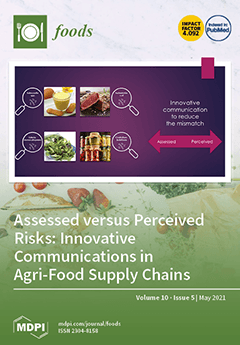Salmorejo is a traditional Spanish food made of raw tomatoes, bread, garlic, and virgin olive oil. The food industry aims to satisfy consumer demand for ready-to-eat
salmorejo while trying to maintain characteristics of the homemade product. In this work, we have assessed physical-chemical
[...] Read more.
Salmorejo is a traditional Spanish food made of raw tomatoes, bread, garlic, and virgin olive oil. The food industry aims to satisfy consumer demand for ready-to-eat
salmorejo while trying to maintain characteristics of the homemade product. In this work, we have assessed physical-chemical and color parameters, radical scavenging activity, and total polyphenol, lycopene, and β-carotene contents of raw and pasteurized commercial
salmorejo, as well as homemade (raw)
salmorejo samples. Our results showed that heat treatment had a significant influence on color parameters of
salmorejo, with pasteurized samples being less red and exhibiting an increase in the degree of browning. Pasteurized samples also showed the highest radical scavenging activity when expressing the results per dry weight. However, when water content was considered, radical scavenging activity was superior in homemade samples when analyzing non-polar molecules extracted with acetone. Results were similar for polyphenol content. It was also observed that heat treatment affected lycopene but not β-carotene content. When acquiring commercial
salmorejo at the supermarket, consumers have the option to choose between already prepared pasteurized or raw
salmorejo. According to the results obtained in this work, physicochemical and functional properties of commercial raw
salmorejo were comparable to a larger extent than pasteurized
salmorejo compared to those exhibited by homemade
salmorejo samples.
Full article






